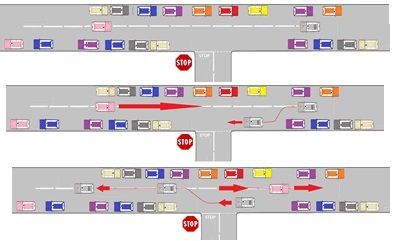Two second gap, hold back position, overtaking, adequate clearance when overtaking stationary & slow moving vehicles
- M.S.M routine when stopping (including turning)
- Improving clutch control
- Co-ordination of foot controls
- Steering to a safe driving position and pulling up on the left
- Gear changing up and down
Risk responsibility's
- Full talk through
- Prompt
- Independent.
- Two second gap
- Hold back position
- Overtaking, adequate clearance when overtaking stationary & slow moving vehicles
- Extending M.S.M to M.S.P.S.G routine (hazard routine)
- Introduce you to L.A.D.A routine
Judgement
You were marked on:
- overtaking
- meeting
- crossing
You needed to show good judgement when overtaking, meeting and crossing other road users, such as knowing when to proceed, and when to wait for a safer opportunity.
You needed to make your intentions clear, and understand the intentions of the other road users.
Examples of faults
Some of the most common faults for this area include:
- not giving way to road users that have priority
- reacting late when meeting an approaching vehicle
- being too close to a cyclist when overtaking
- crossing the path of an oncoming vehicle when turning right
Your examiner may have explained the specific details of any faults you made.
How you can improve in this area
If you made faults in this area during your test, or if you want to improve in this area, you should:
check rules 162 to 169 and rules 179 to 183 of The Highway Code
read section 7 of ‘The Official DVSA Guide to Driving: the Essential Skills’ (2022 edition)
If you need to rebook the test, spend time practising this skill with your driving instructor or supervising driver.
Information about the fault on the DL25 report form

Subject brief
The two second rule
One of the biggest dangers on the road these days is tail gating (getting to close to the vehicles in front and behind).
Always maintain a 2 second safety gap as your vehicle

- Give 1 metre clearance
(door length) from
parked vehicles
and from
the centre line
when travelling at 30mph
- Give ½ metre clearance (1/2 door length) from parked vehicles and from the centre line when travelling at 15mph
- If you are less than 1/4 of a door length (wing mirror distance) from parked vehicles and from the centre line when travelling reduce your speed to a walking or crawling pace 5mph

Overtaking slow moving vehicles (cyclists)
The overtaking manoeuvre requires you again to employ the hazard drill at least three times.
- Look & assess to ensure it is safe to overtake the cyclist safely (including all mirrors)
- Before overtaking check mirrors (interior & right door mirror, (consider a) signal
- Mirrors (interior & left door mirror as you return back to your normal driving position
The new rule 2023 for pedestrian's and cyclist
Road positioning
When riding on the roads, there are two basic road positions you should adopt, depending on the situation.
Ride in the centre of your lane, to make yourself as clearly visible as possible, in the following situations
- on quiet roads or streets – if a faster vehicle comes up behind you, move to the left to enable them to overtake, if you can do so safely
- In slower-moving traffic - when the traffic around you starts to flow more freely, move over to the left if you can do so safely so that faster vehicles behind you can overtake
- At the approach to junctions or road narrowing where it would be unsafe for drivers to overtake you

Overtaking a horse and rider
The overtaking manoeuvre requires you again to employ the L.A.D.A and hazard drill at least three times.
- Look & assess to ensure it is safe to overtake the cyclist safely (including all mirrors)
- Before overtaking check mirrors (interior & right door mirror, (consider a) signal
- Mirrors (interior & left door mirror as you return back to your normal driving position
Sharing space with pedestrians, horse riders and horse drawn vehicles.
When riding in places where sharing with pedestrians, horse riders or horse drawn vehicles is permitted, take care when passing pedestrians and horse riders, especially children, older adults or disabled people. Slow down when necessary and let them know you are there; for example, by ringing your bell (it is recommended that a bell is fitted to your bike), or by calling out politely.
Remember that pedestrians may be deaf, blind or partially sighted and that this may not be obvious.
Do not pass pedestrians, horse riders or horse drawn vehicles closely or at high speed, particularly from behind.
You should not pass a horse on their left, remember that horses can be startled if passed without warning. Always be prepared to slow down and stop when necessary.

Meeting and overtaking stationary vehicles
When you’re approaching a stationary vehicles always use the L.A.D.A and hazard routine's a minimum of 3 times.
1. Once before you think about move out to overtake
2. Once before you overtake the stationary vehicle
3. Then again before you move back to your normal road position

- Mirrors
right
- Position so you’re next to the centre line (above diagram)
- Mirrors right
- Position just over the centre line
- Mirrors left
- Position move to your normal road position
- Making progress
- Mirrors right
- Position so your vehicle is just left of the centre of the centre while line
- (Speed) - reduce your speed to a walking/crawling pace, so you can slow and flow (if possible), if you do not achieve this just hold back a minimum of 2/6 length vehicles back from the parked vehicle
- Gears down, 2nd if you have timed the reduction of your vehicles speed or 1st gear if you needed to stop to let the cars get past the hazard (so far you have used M.P.S.G)
- Mirrors right (again)
- Signal (unless it could misleads any other road user)
- Position so you’re over the centre line (like in the above diagram)
- Speed (increase)
- Gear (change up to make progress)
- Mirrors left
- Position move to your normal road
- Speed (increase your pace)
- Gears (to making progress)
- Mirrors right
- Position so your vehicle is just left of the centre of the road but this time you will need to hold back a minimum of 2/6 length vehicles back from the parked vehicle
- Speed reduce your speed to a crawling pace or stop if it a big queue
- Gears down, probably 1st gear, to let the cars get past the hazard (so far you have used M.P.S.G)
- Mirrors right (again)
- Signal (unless it could misleads any other road user)
- Position so you’re over the centre line (like in the above diagram)
- Speed (increase)
- Mirrors left
- Position move to your normal road
- Speed (increase your pace)
- Gears (to making progress)

- Agree learning goals and needs of todays lesson
- Agree appropriate lesson structure (full, partially or independent level of instruction)
- Practice in a suitable training area
- Directional instructions will be given in ADI format (Alert, direction and identify manor) given to the pupil clear and given in good time
- Agree if the students made a minor, serious or dangerous error on your lesson it will be broken down using F.I.S.H (fault, implications, solution & help) this method of feedback helps pupils understand what fault is being made and how to strategies on how correct the faults.
- Your driving instructor will adapt their teaching style to suite your ability and ability
- Your driving instructor will continue to encourage you on your lesson and analyse any problems made and allow you to take responsibility for your own learning goals by giving you technical information to improve your techniques. Your technical feed back from your instructor will be ether given on the move or if feel needed by pulling you up on the side of the road somewhere safe, legal and convenient.


